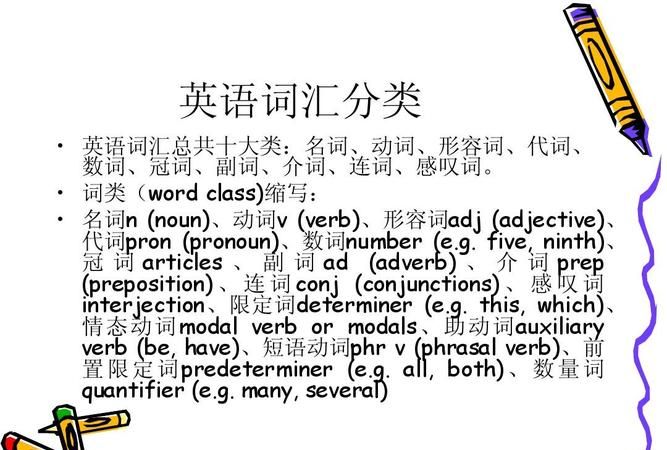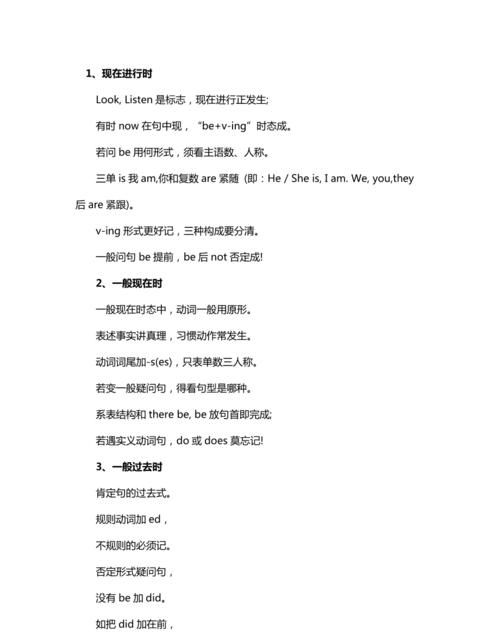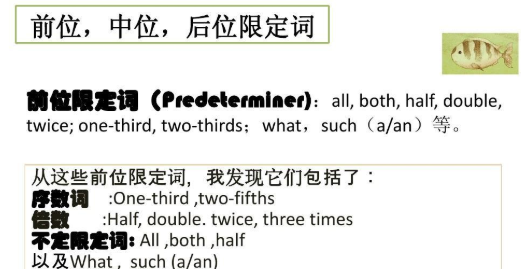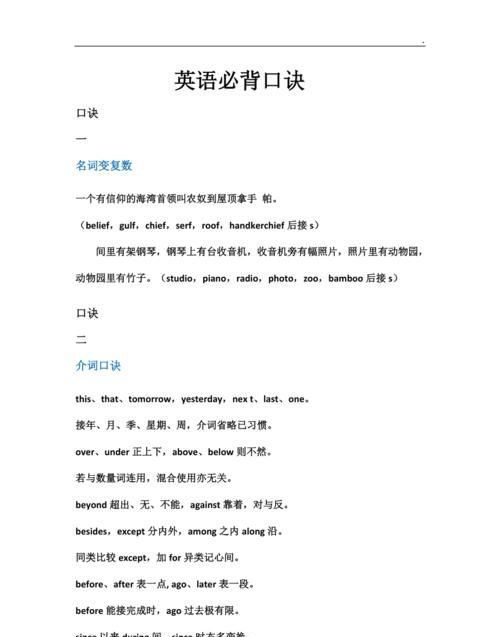本文目录
多层定语的顺序口诀
口诀:限观形龄色国材。限观形龄色国材:限定词(一般指数量);外观(美丽等);形状(大小,高矮,肥瘦);年龄;颜色;国籍;材料;用途。在英语里,一般定语前置时的次序为:限定词,形容词、分词、动名词和名词性定语。
多层定语的排列原则
多层定语的一般是按照逻辑关系来排列的,与中心语关系越密切的定语越靠近中心语。
多层定语的顺序口诀是(从离中心词最远的算起):a、表示领属或时间,处所的名词、代词或短语,表示“谁的”;b、指示代词,数量短语,表示“多少”;c、动词,动词性短语表示“怎么样”;d、形容词,形容词短词表示“什么样”;e、表示性质的名词或名词性短语(表示“什么”)。
多层定语的排列还遵循以下的规律:
1、带“的”的定语一般放在不带“的”的定语之前。例如,只能说“蓝色的呢子大衣”,不能说“呢子蓝色的大衣”。其中,不带“的”动词直接作定语修饰中心语,在形容词和名词之后,例如“一顿丰盛的烤羊肉”、“新型取暖设备”。
2、结构复杂的定语一般放在结构简单的定语之前。例如“刚从国外进口的教学用的数码录音设备”,一般不能说成“教学用的刚从国外进口的数码录音设备”。

英语中限定词的先后顺序应遵循什么规律
限定词(DETERMINER〕是在名词词组中对名词中心词起特指(SPECIFIC REFERENCE〕、类指(GENERIC REFERENCE〕以及表示确定数量(DEFINITE QUANTITY〕和非确定数量(INDEFINITE QUANTITY〕等限定作用的词类.名词词组除有词汇意义外,还有其所指意义(REFERENTIAL MEANING〕,是特指(即指特写的对象〕,还是类指(即泛指一类人或物〕;是有确定的数量,还是没有确定的数量.能在名词词组中表示这种所指意义的词类就是限定词.英语的限定词包括: 定冠词(DEFINTITE ARTICLE〕,不定冠词(INDEFINITE ARTICLE〕,零冠词(ZERO ARTICLE〕 物主限定词(POSSESSIVE DETERMINER〕,my, your, his, her, our, your, their, one's, its. 名词属格(GENITIVE NOUN〕,John's, my friend's. 指示限定词(DEMONSTRATIVE DETERMINER〕,this, that, these, those, such. 关系限定词(RELATIVE DETERRMINER〕,whose, which. 疑问限定词(INTERROGATIVE DETERMINER〕,what, which, whose. 不定限定词(INDEFINITE DETERMINER〕,no, some, any, each, every, enough, either, neither, all, both, half, several, many, much, (a) few, (a) little, other, another. 基数词(CARDINAL NUMERAL〕和序数词(ORDINAL NUMERAL〕 倍数词(MULTIPLICATIVE NUMERAL〕和分数词(FRACTIONAL NUMERAL〕 量词(QUANTIFIER〕a lot of, lots of, plenty of, a great of, a good deal of, a large of, a small amount of, a quantity of, a great of, a good number of等. 限定词与名词词组中心词之间有着某种固定的搭配关系;如果名词之前带有两个或两个以上的限定词,则限定词与限定词之间也有某种固定的搭配关系.本讲主要解决这两种搭配关系问题. 1 限定词与三类名词的搭配关系 限定词的选择决定于随后的名词的类别,是单数名词、复数名词,还是不可数名词. 1〕能与三类名词搭配的限定词 有些限定词如the, some, any, no, other, whose以及my, your等物主限定词和名词属格(John's, my friend's〕等能与三类名词搭配.例如: the book, my book, my friend's book, John's book, any book, some book, no book, the other book, whose book, the books, my books, my friend's book, John's books, any books, some books, no books, the other books, whose books, the money, my money, my friend's money, John's money, any money, some money, no money, the other money, whose money. 2〕只能与单数名词搭配的限定词 有些限定词如a(n), one, another, each, every, either, neither, many a, such a 等只能与单数名词搭配.例如: each worker, either book, an apple, another book, such a book, every student, neither sentence, one copy, many a book. 3) 只能与复数名词搭配的限定词 有些限定词如both, two, three, another two / three, many, (a) few, several, these, those, a (great) number of等只能与复数名词搭配.例如: both workers, several students, a number of essays, many students, (a) few words, these / those books, two / three visitors, another two / three students. 4) 只能与不可数名词搭配的限定词 有些限定词如a (little) bit of, a great amount of, a great deal of, (a) little, much等只能与不可数名词搭配.例如: a bit of water, a great amount of labour, a great deal of work, (a) little space, much noise. 5〕能与单、复数名词搭配的限定词 有些限定词如the first, the second, the last, the next等既可与单数名词搭配,也可与复数名词搭配.例如: the first rose, the last man, the next meeting, the first roses, the last men, the next meetings. 6〕能与单数名词和不可数名词搭配的限定词 有些限定词如this, that, (the) least等能与单数名词和不可数名词搭配.例如: (the) least sign (of prejudice), this / that job, (the) least knowledge, this / that work. 7〕能与复数名词和不可数名词搭配的限定词 还有些限定词如a lot of, lots of, enough, more, most, such, other等可与复数名词和不可数名词搭配.例如: a lot of books, a lot of money, lots of chickens, lots of food, plenty of chairs, plenty of water, enough copies, enough coal, more articles, more time, most people, most work, such men, such bread, other men, other bread. 不定量限定词less原先只与不可数名词搭配,但在现代英语中,less既可与不可数名词也可与复数名词搭配.例如: less money, less mistakes. 2 限定词与限定词的搭配关系 以上讲的是限定词与三类名词的搭配关系.除上述搭配关系外,限定词与限定词之间还存在着一定的搭配关系.在名词词组中心词之前如果有两个或两个以上限定词出现时,就会产生限定词的先后顺序问题.按其不同的搭配位置,限定词可分为: 1〕中位、前位、后位限定词 按照限定词与限定词之间不同搭配位置,限定词可分为中位限定词(CENTRAL DETERMINER〕、前位限定词(PREDETERMINER〕和后位限定词(POSTDETERMINER〕. a) 中位限定词包括a(n), the, zero; this, that, these, those; my, your, etc; Merry's, my friend's; some, any, no, every, each, either, neither, enough; what(ever), which(ever), whose等 b) 前位限定词包括all, both, half; double, twice, three times, etc; one-third, two-fifths, etc; what, such, (a / an)等 c) 后位限定词包括one, two, three, etc; first, second, third, etc; next, last, other, another, etc; many, much, (a) few, (a) little, fewer, (the) fewest, less, (the) least, more, most; several, plenty of, a lot of, lots of, a great / large / good number of, a great / good deal of, a large / small amount of; such等 2) 三类限定词的搭配关系 如果一个名词词组带有上述三类限定词,其搭配关系总是按照"前位--中位--后位"的顺序排列.例如: all前the中four后teachers. all前your中three后books. all前these中last后few后days. 如果只有上述两类限定词,其搭配关系仍按上述顺序.例如: half前his中lecture. those中last后few后months. several后hundred后guests. all前other后students. such前a中misfortune. some中such后alloy. 由上述诸例可以看出,中位限定词之间和前位限定词之间是互相排拆的,即一个名词中心词之前不可并用两个中位限定词或两个前位限定词.所以,"我的那本书"不是* my that book而是that book of mine,因为my和that同是中位限定词,不可同时并列.但后位限定词的使用却不受此限.除上述those last few months, several hundred guests之外, this last two books, the first two chapters, three other girls, two more sheets, the next few weeks, many more copies, a few more samples, another twenty tons等都是后镁限定词重叠使用的实例. 个别限定词有跨类现象,如such既属于前位限定词,又可归入后位限定词.由于它只是在such a...和such an...这样的搭配中属于前位限定词,而在与其他限定词(some, any, no, all, few, another, other, many, one, two, etc)搭配时,such则是后位限定词,一律放在上述这些限定词的后面,如some such, any such, nosuch, few such, one such等,因此本书把它归入后位限定词. 3 若干限定词用法比较 前两节介绍了限定词与三类名词以及限定词与限定词之间的搭配关系.下面介绍一些限定词(包括相应的不定代词〕的某些习惯用法问题.( 本节所讲的"不定代词"多属于"名词性替代词"(NOMINAL SUBSTITUTE〕,参见37.1) 1〕many, much, a lot of, lots of, plenty of 表示"多"的意思,可用many, much, a lot of, lots of, plenty of等.但是many, much常用于否定句和疑问句,而a lot of等则常用于肯定句.例如: I haven't seen many English films. 多数英文电影我没看过. many修饰可数名词 Have you seen many English films? 多数的英文电影你都看过吗? many修饰可数名词 I haven't done much work today. 我还没有做多少活呢. much修饰不可数名词 Have you done much work today? 今天你已经做了很多活吗? much修饰不可数名词 I have seen a lot of / lots of / plenty of / a great number of English films. 我已经看了多部英文电影. number修饰可数名词 I have done a lot of / lots of / plenty of / a great amount of work today. 今天我已经做了很多活.amount修饰不可数名词 many / much 既可作限定词,也可作不定代词(INDEFINITE PRONOUN〕,a lot 也可单独用作名词词组: Have you done all these exercises? ----No, I haven't done very many. Have you done much work today? ----Yes, I've done a lot. 当然,以上所讲many / much常用于否定句和疑问句并不是绝对的,尤其是在下列场合many / much也常用于肯定句: a) 用于whether / if引导的宾语分句中.例如: I doubt whether / if there'll be many people at the show on this rainy day. 我怀疑在这个雨天里会有很多人看表演. I wonder whether / if he has much information on this subject. 我想知道在这个题目上他是否知道很多消息

限定词的顺序口诀7个字颜国才
限定词的顺序口诀7个字:
一、限:限定词。the, my, a, this。
二、描:描绘性形容词。brave, beautiful, lovely, nice。
三、大:大小、高低、长短等形容词。big,large,small。

四、形:形状。round,square。
五、龄:年龄大小、新旧、年代等。young,old,new。
六、颜:颜色。red,blue,green。
七、籍:国籍、地区、出处。Chinese,America,Japanese。
英语中限定词的位置顺序
限定词可以分为前位限定词、中位限定词和后位限定词。
一、中位限定词
定冠词、不定冠词/ this / that / these / those / my / your / Merry's / my friend's / some / any / every / each / no /
在名词中心词之前只能出现一个这样的词。
a the boy a some boy
二、前位限定词
只能出现在某些中位限定词之前
1. all, both , half
eg. all the girls, half an hour
2. 倍数词 double, twice, three times
double the sum, twice my salary, three times the space 3. 分数词 one-third, one-fifth
One-third the time
4. such, what
such a surprise! What a fine day !
前位限定词是互相排斥的,如不能说all both girls。
all such 是个例外。
个别限定词有跨类现象。如such既属于前位限定词,又可归入后位限定词。由于它只是在 such a...和such an...这样的搭配中属于前位限定词。而在与其他限定词(some, any, no, all, few, another, other, many, one, two, etc)搭配时,such则是后位限定词,一律放在上述这些限定词的后面。
三、后位限定词
接在前位限定词或中位限定词后面
1. 基数词 my three children
2. 序数词 the first day, the last day
(一般序数词,last, next, past, another, additional, further)
3. 封闭类数量词 few people
4. 开放类数量词 a large number of people
希望我能帮助你解疑释惑。

以上就是关于英语限定词顺序口诀,多层定语的顺序口诀的全部内容,以及英语限定词顺序口诀 的相关内容,希望能够帮到您。
